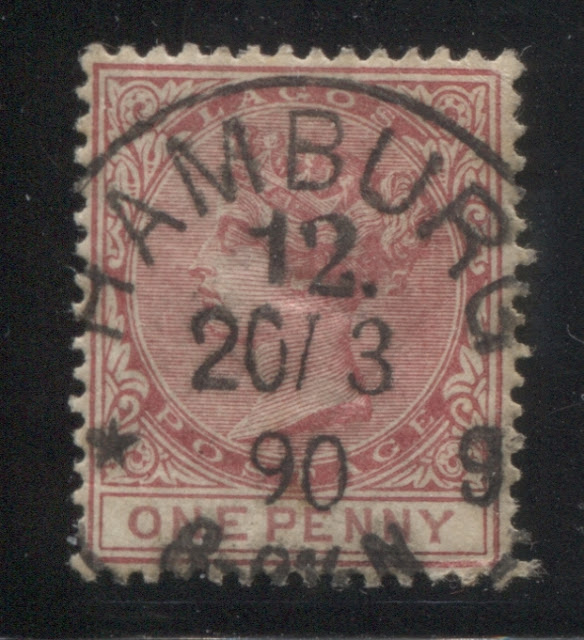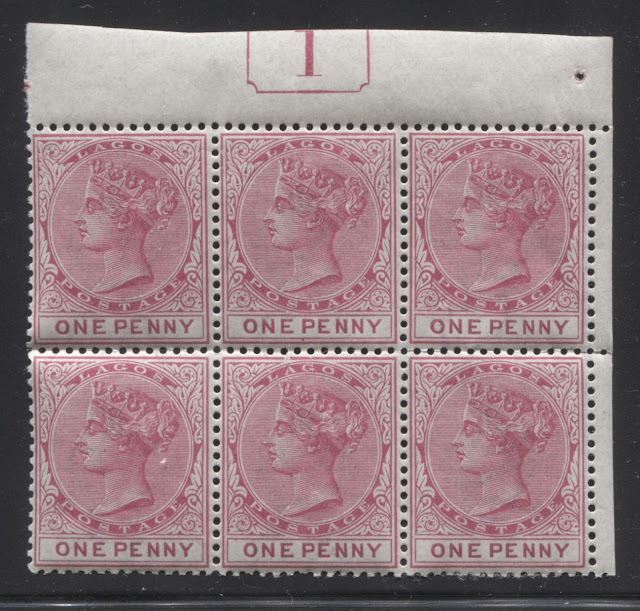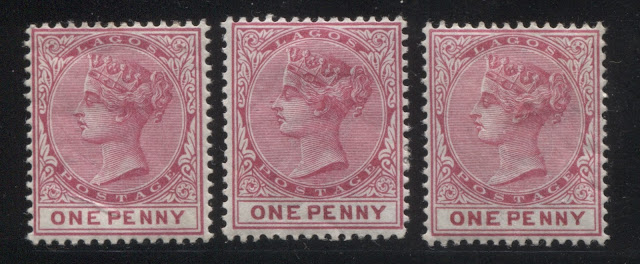Today, I pick up where I left off last week, which was to look at all the printings of the 1d carmine stamps that were made after March 1887, from the first state of the plate. I had stated in last week's post that I expected to find approximately 12 printings from this state of the plate. As it turns out, I found 16 different printings, which could mean that either there really were that many printings from the first state of the plate during those first four years or so after 1886, or three or four of the printings identified really belong in the first group of 11 printings that were made before 1887.
In this group of printings there are a number of constant plate flaws that involve the duty plate lettering, and these will be illustrated and described. Some of them were proven to have originated in the earlier crown CA or Crown-CC issues, and some are new. They are all scarce, as it would seem that they only occur once on the sheet.
Group 1: Printings 12-27 From the First State of the Plate - March 1887 to December 1889 or January 1890
Twelfth Printing
The head plate colour of this printing is closest to what I would call deep bright carmine, while the duty plate colour is very close to Gibbons's deep carmine.
This printing shows another plate flaw that may or may not be constant. I call this one the "plugged E in One". In this variety, the white space that would normally be between the top of the "E" and the centre bar of the "E" is almost entirely filled in with colour. It is quite a prominent and spectacular flaw as these flaws go.
The enlarged scan shows this flaw very clearly:
In this group of printings there are a number of constant plate flaws that involve the duty plate lettering, and these will be illustrated and described. Some of them were proven to have originated in the earlier crown CA or Crown-CC issues, and some are new. They are all scarce, as it would seem that they only occur once on the sheet.
Group 1: Printings 12-27 From the First State of the Plate - March 1887 to December 1889 or January 1890
Twelfth Printing
Of all the printings of this stamp, this is probably the most distinct. The head plate and duty plate colours are identical, and is closest to Gibbons's lake shade, but is duller. No other printing comes close to this in terms of the proximity to burgundy that this shade is.
In addition to the distinctness of the shade, this stamp shows the constant plate flaw that I call the "truncated NY" In this flaw, the second leg of the second "N" and the left branch of the "Y" in "Penny" are shorter than the first leg and right branch respectively. All of these letters are normally supposed to be the exact same height.
The close up scan below shows the flaw more clearly:
Thirteenth Printing
The head plate colour of this printing is carmine lake, while the duty plate colour is closest to a very dull carmine lake. This sole used example is cancelled with an 8-bar Lagos oval obliterator.
Fourteenth Printing
The head plate colour of this printing is closest to Gibbons carmine red, but this colour is much duller. So I would call it dull carmine red. The duty plate colour is basically the same, as the head plate colour, except that it is both paler and even duller still. So I would call this dull carmine red and pale dull carmine red.
Interestingly, this stamp is cancelled in Hamburg, Germany. I presume that it was either cancelled aboard one of the German steamers that carried mail into and out of Lagos, or it was cancelled upon arrival in Germany. Either way, this is a fantastic example of an early foreign use cancel.
Fifteenth Printing
On this printing, both the head plate and duty plate colour are an almost perfect match to Gibbons' rose carmine shade.
Sixteenth Printing
The head plate colour of this printing is closest to Gibbons's carmine, but with a decidedly bluish undertone. The duty plate colour is an almost perfect match to Gibbons's crimson shade.
I have one mint example and one used example that is cancelled with an 8-bar oval obliterator.
Seventeenth Printing
The head plate colour of this printing is very close to Gibbons's carmine shade, but is just a touch brighter than the Gibbons swatch, though not as bright as the bright carmine. The duty plate colour is identical to that of the last printing and is a near perfect match to Gibbons's crimson shade.
I have the above mint example, and a beautiful, never hinged, top margin block of six from the top of the sheet showing the current number in the selvage. This number was a sequencing number used by De La Rue in the laying down of the plates for the colonies. The system was abandoned in 1891, so blocks that show this number can be reckoned as having been printed before then.
Eighteenth Printing
Again, the head plate colour of this printing is closest to carmine, but this is much brighter and deeper than what the Gibbons swatch shows. I would call it a deep, bright carmine. The duty plate colour is similar to Gibbons's crimson shade, but deeper and brighter. So I would call this deep bright carmine and deep bright crimson.
I have three examples of this printing, all of which are mint, as shown above.
Nineteenth Printing
On this printing, the head plate colour is closest to Gibbons's carmine shade, but with a decidedly bluish undertone, very similar to the 16th printing. The duty plate colour is an almost perfect match to the Gibbons carmine shade.
This is the printing that I have the largest number of examples of from this period. Four are mint, one has what appears to be a very mysterious cancel, but also has its full gum. So this stamp is intriguing. The last example is a manuscript cancel dated March 26, 1892. The colour has run from exposure to water, so its inclusion here is based on conjecture.
Twentieth Printing
The head plate colour of this printing is closest to Gibbons' rose carmine, but deeper. The duty plate colour is closest to Gibbons'd deep carmine. So I would classify this as deep rose carmine and deep carmine.
Twenty First Printing
On this printing, both the head plate and duty plate colours are closest to Gibbons's carmine shade. Of the four examples I have here, only one is mint and the other three are used. Two of these are cancelled with strikes of the Lagos 8-bar oval obliterator, while one is cancelled with a September 12, 1892 Lagos 21 mm CDS.
Twenty Second Printing
On this printing the head plate colour is closest to deep rose carmine, while the duty plate colour is carmine.
Both these used examples are cancelled with postmarks that were contemporary for the period, including an 8-bar oval obliterator and and 1891 Lagos 21 mm CDS cancel.
Twenty Third Printing
Both the head plate colour of this printing and the duty plate colour are closest to Gibbons's deep carmine shade. This colour is a little bit lighter, but it is clearly deeper than carmine.
Twenty Fourth Printing
The head plate colour of this printing is closest to Gibbons carmine, but a little deeper, and with a bluish undertone. The duty plate colour is a perfect match to Gibbons's deep carmine. So I would call this the deeper bluish carmine and deep carmine.
I have no used or mint examples with gum of this printing. The above unused example with a corner wrinkle is the only example I have seen.
Twenty Fifth Printing
The head plate colour of this printing is close to the carmine shade on the Gibbons key, but is much brighter , with a rosy undertone. The duty plate colour is carmine.
Twenty Sixth Printing
The head plate colour of this printing is carmine with a deep bluish undertone, while the duty plate colour is deep carmine.
This example shows the second plate flaw that I have found on this value, which should be constant. I call it the "truncated N and nick in O". This flaw consists of a small nick taken out of the right side of the "O" of "One", and the left foot of the "N" of "One"is shaved diagonally at the base. Normally, both sides of the N should be the same height and should be squared off, rather than angled, as this one is. The close up scan should show this very clearly:
Twenty Seventh Printing
The head plate colour of this printing is closest to what I would call deep bright carmine, while the duty plate colour is very close to Gibbons's deep carmine.
This printing shows another plate flaw that may or may not be constant. I call this one the "plugged E in One". In this variety, the white space that would normally be between the top of the "E" and the centre bar of the "E" is almost entirely filled in with colour. It is quite a prominent and spectacular flaw as these flaws go.
The enlarged scan shows this flaw very clearly:
This concludes my review of the first printings of this value from the first state of the plate. Next week, I will begin looking at the printings of the 1/2d and 1d stamps that were made from the second state of the plate.





















